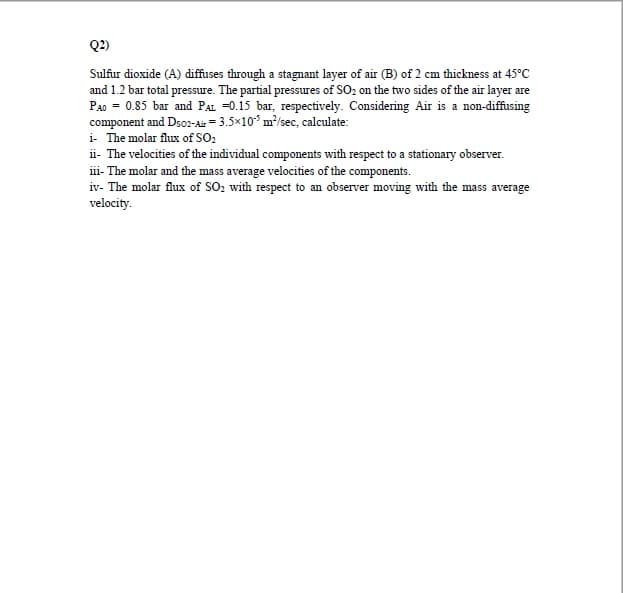Sulfur dioxide (A) diffuses through a stagnant layer of air (B) of 2 cm thickness at 45oC and 1.2 bar total pressure. The partial pressures of SO2 on the two sides of the air layer are PA0 = 0.85 bar and PAL =0.15 bar, respectively. Considering Air is a non-diffusing component and DSO2-Air = 3.5×10-5 m2/sec, calculate: i- The molar flux of SO2 ii- The velocities of the individual components with respect to a stationary observer. iii- The molar and the mass average velocities of the components. iv- The molar flux of SO2 with respect to an observer moving with the mass average velocity.
Sulfur dioxide (A) diffuses through a stagnant layer of air (B) of 2 cm thickness at 45oC and 1.2 bar total pressure. The partial pressures of SO2 on the two sides of the air layer are PA0 = 0.85 bar and PAL =0.15 bar, respectively. Considering Air is a non-diffusing component and DSO2-Air = 3.5×10-5 m2/sec, calculate: i- The molar flux of SO2 ii- The velocities of the individual components with respect to a stationary observer. iii- The molar and the mass average velocities of the components. iv- The molar flux of SO2 with respect to an observer moving with the mass average velocity.
Introduction to Chemical Engineering Thermodynamics
8th Edition
ISBN:9781259696527
Author:J.M. Smith Termodinamica en ingenieria quimica, Hendrick C Van Ness, Michael Abbott, Mark Swihart
Publisher:J.M. Smith Termodinamica en ingenieria quimica, Hendrick C Van Ness, Michael Abbott, Mark Swihart
Chapter1: Introduction
Section: Chapter Questions
Problem 1.1P
Related questions
Question
Sulfur dioxide (A) diffuses through a stagnant layer of air (B) of 2 cm thickness at 45oC and 1.2 bar total pressure. The partial pressures of SO2 on the two sides of the air layer are PA0 = 0.85 bar and PAL =0.15 bar, respectively. Considering Air is a non-diffusing component and DSO2-Air = 3.5×10-5 m2/sec, calculate:
i- The molar flux of SO2
ii- The velocities of the individual components with respect to a stationary observer.
iii- The molar and the mass average velocities of the components.
iv- The molar flux of SO2 with respect to an observer moving with the mass average velocity.

Transcribed Image Text:Q2)
Sulfur dioxide (A) diffuses through a stagnant layer of air (B) of 2 cm thickness at 45°C
and 1.2 bar total pressure. The partial pressures of SO2 on the two sides of the air layer are
Pa0 = 0.85 bar and PAL =0.15 bar, respectively. Considering Air is a non-diffusing
component and Dso2-Ai = 3.5×10° m²/sec, calculate:
i- The molar flux of SO2
ii- The velocities of the individual components with respect to a stationary observer.
iii- The molar and the mass average velocities of the components.
iv- The molar flux of SO2 with respect to an observer moving with the mass average
velocity.
Expert Solution
This question has been solved!
Explore an expertly crafted, step-by-step solution for a thorough understanding of key concepts.
Step by step
Solved in 4 steps

Knowledge Booster
Learn more about
Need a deep-dive on the concept behind this application? Look no further. Learn more about this topic, chemical-engineering and related others by exploring similar questions and additional content below.Recommended textbooks for you

Introduction to Chemical Engineering Thermodynami…
Chemical Engineering
ISBN:
9781259696527
Author:
J.M. Smith Termodinamica en ingenieria quimica, Hendrick C Van Ness, Michael Abbott, Mark Swihart
Publisher:
McGraw-Hill Education

Elementary Principles of Chemical Processes, Bind…
Chemical Engineering
ISBN:
9781118431221
Author:
Richard M. Felder, Ronald W. Rousseau, Lisa G. Bullard
Publisher:
WILEY

Elements of Chemical Reaction Engineering (5th Ed…
Chemical Engineering
ISBN:
9780133887518
Author:
H. Scott Fogler
Publisher:
Prentice Hall

Introduction to Chemical Engineering Thermodynami…
Chemical Engineering
ISBN:
9781259696527
Author:
J.M. Smith Termodinamica en ingenieria quimica, Hendrick C Van Ness, Michael Abbott, Mark Swihart
Publisher:
McGraw-Hill Education

Elementary Principles of Chemical Processes, Bind…
Chemical Engineering
ISBN:
9781118431221
Author:
Richard M. Felder, Ronald W. Rousseau, Lisa G. Bullard
Publisher:
WILEY

Elements of Chemical Reaction Engineering (5th Ed…
Chemical Engineering
ISBN:
9780133887518
Author:
H. Scott Fogler
Publisher:
Prentice Hall


Industrial Plastics: Theory and Applications
Chemical Engineering
ISBN:
9781285061238
Author:
Lokensgard, Erik
Publisher:
Delmar Cengage Learning

Unit Operations of Chemical Engineering
Chemical Engineering
ISBN:
9780072848236
Author:
Warren McCabe, Julian C. Smith, Peter Harriott
Publisher:
McGraw-Hill Companies, The